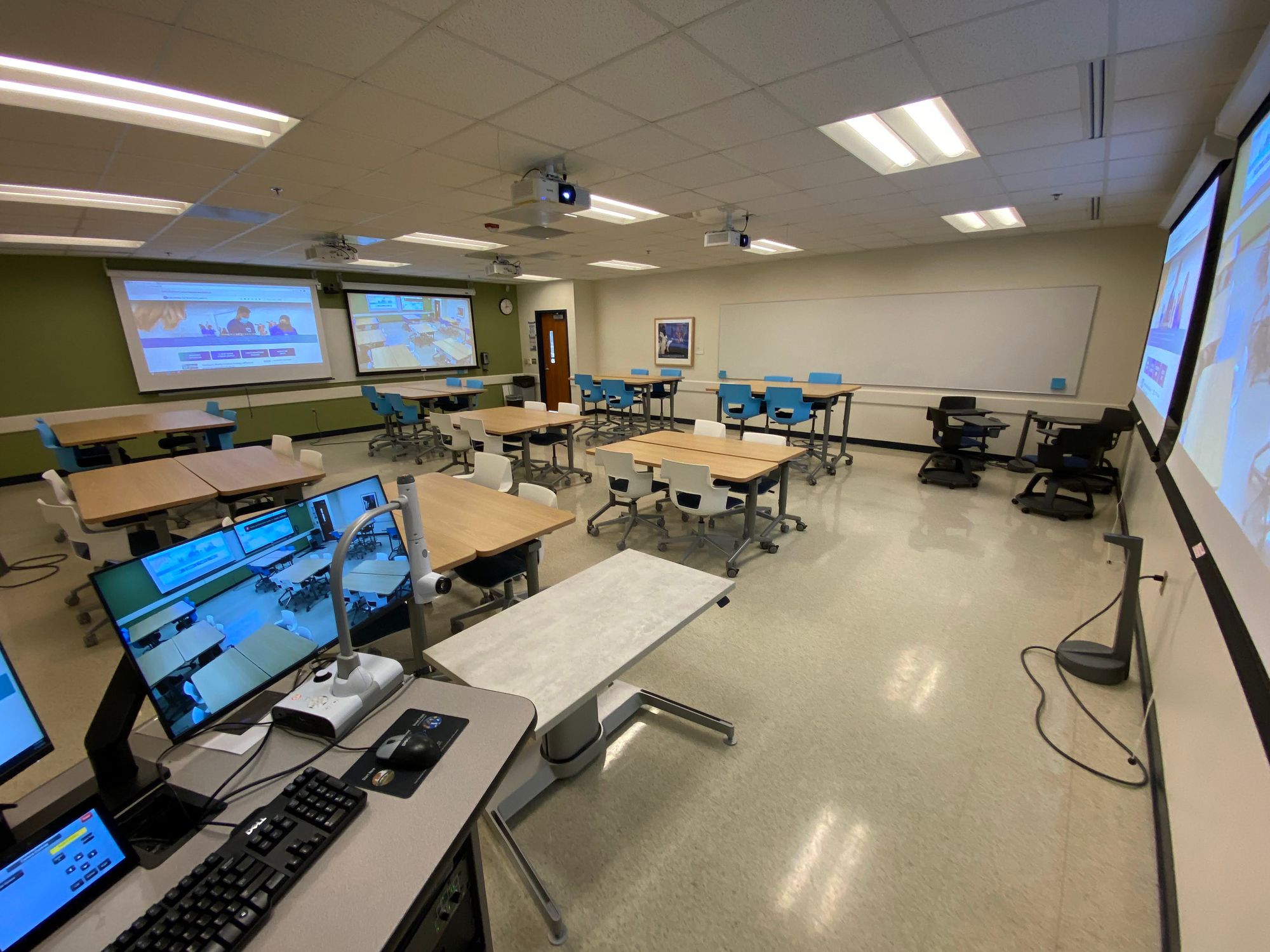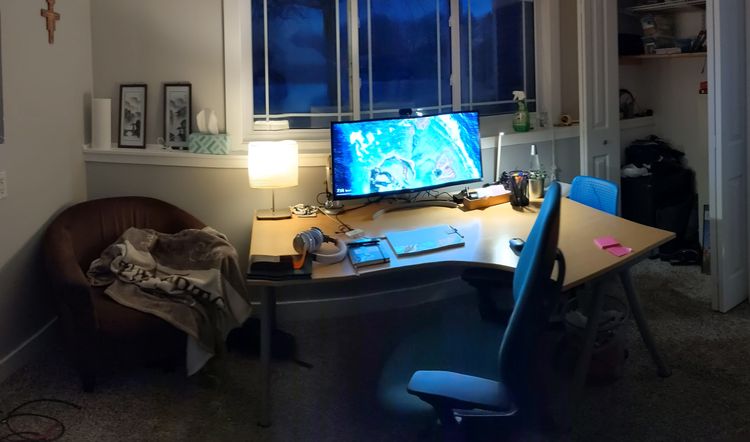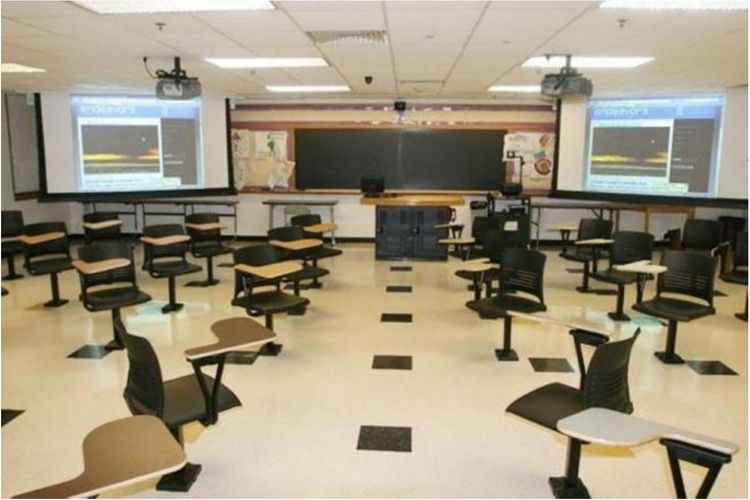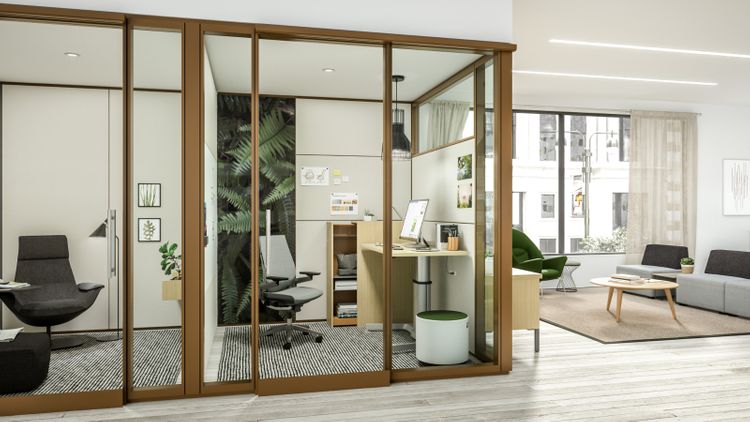What it's like to teach in an active learning classroom

Over the last several years, I have done a lot of work with active learning classrooms (ALCs). These are classroom spaces that are intentionally designed to optimize active learning and amplify its positive effects. They can look like a lot of different things, but they typically all have a flexible configuration (often with wheels on the chairs and tables); a "polycentric" design with no dedicated "front" or "back" of the room.; and easy access to digital and analog learning tools including whiteboards, projectors, and power supplies.
As most readers know, I spent the 2017-2018 academic year on sabbatical at Steelcase doing research on active learning spaces, which resulted in this comprehensive literature review paper co-authored with architect Anat Mor-Avi. The research is fairly clear that when used properly (and good faculty training is key here), ALCs really do boost the already-strong positive effects of active learning. In my current role in the GVSU President's Office, I'm running point on several initiatives to get more ALCs on our campus and build community around them.
But although I'd done research on ALCs and even conducted workshops and training sessions in them, I had never actually taught a college class in one -- until this semester. I've learned a lot over these ten weeks that my sabbatical work only hinted at. After ten weeks of teaching in an ALC, I wanted to report back on what it's like.
What, how, and where I am teaching
This semester I am teaching two sections of Modern Algebra, the first of a two-semester sequence on abstract algebra mostly taken students in Math Education or Pure Mathematics. It's a proof-based (read: writing-intensive) course on basic number theory, rings, and fields. I've taught this course over a dozen times, and the subject was a big part of my Ph.D. work as well.
Despite that personal investment in the subject, I'd always struggled to bring the material to life with my students. Abstract algebra requires active interaction with the ideas in order to make sense of them and understand what the subject is about. While that makes it a great candidate for an active learning approach, real active engagement in my classes has seemed elusive.
Looking back, I think the kind of space in which I taught was one of the main barriers. I'd always taught in "traditional" rooms – ordinary tables and chairs, a single whiteboard at the "front" (which was clearly defined), and so on. While it was possible to move the tables and chairs around, just about the only thing I could do with the space is arrange tables and chairs into groups of four. You can have highly effective active learning in a space like that, but it's still limiting the activity just to what you can put in front of students. The students are still seated, working on a piece of paper or maybe a computer.
This isn't how mathematicians actually work, though. When a mathematician works, we're often doing lots of different things -- standing up at a whiteboard throwing out ideas, moving around between seated and standing positions (or just pacing the room), interacting with collaborators who are doing the same, and jumping from one context to the next -- seated to standing, silent to verbose, digital to analog, all within the same working session. And whatever tools we need to do this work are on hand, their presence often suggesting the modes in which the work itself takes place. (Put a stack of post-it notes on your desk right now and see if your brain doesn't automatically start thinking of how to use it.) This is way more than just "working in groups".
When I learned I'd be teaching the course again this semester, I knew I wanted to make changes, so that what students did in class meetings simulated the actual working practices of real mathematicians. I decided to restructure the course around inquiry-based learning which centers class meetings around oral presentations of student work to fuel class discussions; and I decided to use ungrading. When it was announced that two new ALCs were being installed in my building, I jumped at the chance to reschedule the class into that room, since that space seemed far more conducive to the kinds of work I wanted to see.
Here's the room I'm using:

Some key features of this space:
- Everything is on wheels, so the entire room can be configured into anything you can imagine, in a matter of seconds and with virtually no noise or calories burned.
- There are whiteboards covering three of the four walls (I've asked for the fourth one to be covered) and there are no barriers to accessing them.
- There are power supplies that can be picked up and moved to the tables.
- There are cameras mounted on opposite walls of the room that can capture class activities and board work from each direction. The definition of those is such that when fully zoomed in, I can easily read the handwriting of a student sitting in the center of the room.
- There is a bank of microphones mounted in the ceiling that can pick up nuances of conversation. And the microphones and cameras work together to automatically track the camera to whomever is speaking.
How the space impacts learning
It's one thing to do research and and training about ALCs. But you don't get the full effect that these spaces can have on learning until you actually teach a class in one. I noticed those effects from Day 1 of the semester back in January. Ten weeks later, here's what I've learned and noticed:
The flexibility of the room configuration matters -- a lot. Most of the time, we still work in "pods" where the tables are arranged in groups of four. But we don't have to; we can break out of that configuration and into another at any moment. Or, a single student can decide they want to consult with someone in another group, and all it takes is pushing off to roll the chair over to the new group. Although we don't take advantage of the flexibility of the rearrangement, there is a tacit understanding that we could, and that the space is literally bolted to the floor. That freedom, even if untapped, somehow changes the vibe of the class for the better.
The space deliberately decentralizes the instructor -- and that's good. I still sometimes refer to the "back" and "front" of the room because there's an instructor workstation on the opposite side from the entryway, and it's hard to stop referring to that side as "the front". But, whereas planting myself at "the front" of the room in a traditional space is normal, in this space it feels awkward, defensive, and distant. I am far more likely to start there -- mostly because there are some things I use in teaching, like polling software, that can only be controlled from "the front" -- but then relocate and roam around freely the rest of the time. There is definitely not the feeling that there is a "front" 1/3 of the space that is my territory, and the back 2/3 is for the students, and the expectation is students will sit in the back and stare at the front. I don't have a privileged location in this room (apart from the workstation) and everyone is better for it.
My students have a greatly increased sense of ownership. My students act like they own the place. For example, it used to be highly unusual for a student in class to ask to "come up" to the whiteboard to show something. (Because the whiteboard was only in "the front" -- in instructor territory.) Now, students just get up and go! They do not ask either for permission or forgiveness. They really treat the space as their space. In fact, students in my early section often show up for class 30-45 minutes early, just to use the space to work. And I think that sense of ownership carries over from the space itself to the math that we do in the space.
The audio-visual tech in the room matters a lot more than I thought it would. At first, I was skeptical about the cameras and microphones. They felt like (very!) expensive luxuries that we didn't need for an in-person class. A few of my students had some concerns about being on camera while in class. My skepticism started dropping off the first time one of the students had to quarantine for Covid-19 exposure. I told the student to tune in to the Zoom feed instead of missing class. We later agreed that because of the quality of the camera and microphones, it was almost like actually being present in the room, or being present as a hologram.
That student and several others through the semester have been able to participate in class, including doing their theorem presentations, either remotely or in-person with almost no drop-off in quality. Last week, that script was flipped, as I had to isolate for the entire week due to a very bad cold. I taught the classes remotely, and some students showed up in the room and put the Zoom feed on the big screens! Not only were they able to easily manage the technology in the room, I got to have the same remote experience as the earlier students did. For me, it astonishing just how close to the in-person experience this was.
Problems and questions I've encountered
While my experience teaching in an active learning classroom has been overwhelmingly awesome, it's not been without its issues and sticky problems to address.
The biggest of those is the problem of getting good active engagement between learners who are remote and learners who are physically present. Students work in fixed working groups that we set up at the beginning of the semester, so they get familiar with each other. If one member of the group is participating remotely, it's hard if the other three group members are in person. I've tried having the three in-person students hop on the Zoom meeting and then putting them in a breakout room with the remote person. This introduces so much friction (technological and social) in the group work process that the group shuts down. If there are three or more students participating remotely, I've tried putting them into a breakout room on their own, but then they're from different working groups and they're not used to working with each other. So my default has been to have remote participants work individually, which isn't ideal.
I know this is a problem that others have considered, and I'll be doing some research to see what the best solutions are. But in the meanwhile, for me this is the grand challenge of remote instruction.
Another issue has been with students who, for various reasons, don't want to be on camera during class. One student has diagnosed anxiety issues and doesn't want to be recorded. Others have concerns about privacy. These are legitimate concerns and there are no simple tech fixes that I am aware of. The student with anxiety issues asked his group to sit on the periphery of the room, where the camera doesn't record. This works, but it doesn't seem scalable.
And of course, we've had intermittent issues with the tech in the room. The "instructor camera" that points to the workstation area auto-focuses on the instructor but cuts off the top 1/3 of the whiteboard that we might be using for a demonstration. That camera also seems really aggressive about auto-tracking and will track away from a student who is presenting work and toward me, even if I make the slightest noise or movement. These are all things that can be fixed, but they've come up somewhat often -- which is to be expected for a new space, but it's still something to deal with.
Conclusion
For my part, from now on, I only want to teach either online from my home office, or in person but in an ALC. I've been spoiled by the ALC experience and when I inevitably have to go back to teaching in person in a traditional room, it will be hard, and I will whine about it. In the meanwhile, I will enjoy being in an ALC and try to find creative ways to hack the space. I've concluded that ALCs are one of the few educational innovations out there that actually lives up to the hype.
Teaching in an ALC also raises a lot of difficult and fascinating questions about the future of instruction in general. For example, should we start retrofitting all our learning spaces with the A/V tech that my room has, to accommodate remote learners? Would doing so, signal that we are ready to normalize hyflex instruction? If the answer to all that is "no", then what incremental steps should we be taking to get our classroom spaces "up to code" so that they make active learning easier? There are many more such issues and questions to explore, and I'm here for it.


